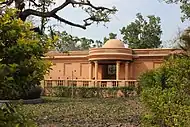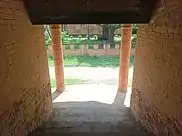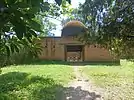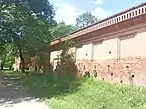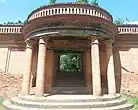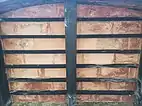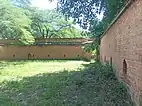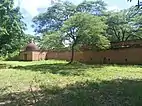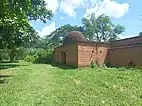Sanggai Yumpham
The Sanggai Yumpham (Old Manipuri: Sangkai Eempham) was a fortified royal residence (citadel[2]) of the Meitei royalties inside the Kangla Fort in Imphal. It is presently preserved as an archaeological site as well as one of the tourist attractions in the Kangla.[3][4][5][6]
| Sanggai Yumpham "The Citadel of the Kangla Fort"[1] | |
|---|---|
Sangkai Eempham | |
| Former names |
|
| Alternative names | |
| Etymology | see here |
| General information | |
| Status | partially demolished |
| Architectural style | Meitei architecture |
| Location | inside the Kangla Fort |
| Town or city | Imphal |
| Country | Manipur Kingdom (historical), India (present) |
| Named for | see here |
| Construction started | 1611 A.D. |
| Demolished |
|
| Client | Ningthouja dynasty |
| Owner | Government of Manipur |
| Governing body | Kangla Fort Board |
| Height | 14 to 20 feet high |
| Technical details | |
| Material | Burned bricks |
| Size | 600 x 600 feet |
| Known for | being ancient royal residence (citadel) |
| Other information | |
| Parking | no |
Etymology
In Meitei language, sanggāi (Meitei: ꯁꯡꯒꯥꯏ) means residence or home, used in formal context.[7] The Meitei term yumpham (Meitei: ꯌꯨꯝꯐꯝ) literally means "the place where a house is built". Morphologically, "yum‑pham" can be divided into two root words, yum (Meitei: ꯌꯨꯝ) and pham (Meitei: ꯐꯝ), meaning 'house' and 'place' respectively.[8]
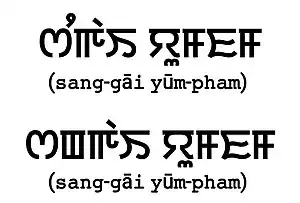
History
The construction of the Citadel of the Kangla Fort in Imphal started in the year 1611 A.D. during the era of Meitei king Khagemba (Old Manipuri: Khākī Ngampa). This fact is recorded in the Cheitharol Kumbaba (Old Manipuri: Cheithalol Kumpapa), the Royal chronicle of the Meitei royalties of Kangleipak (Meitei for 'Manipur Kingdom')).[9][10]
The Kangla Fort was destroyed and abandoned multiple times during Burmese invasion, especially during the Chahi Taret Khuntakpa (Meitei for 'Seven Years Devastation') (1819-1826). Later, the citadel was re-constructed during the reign of Meitei king Chandrakirti Singh in 1873.[11]
As a result of the Anglo Manipur War of 1891, on 27 April 1891, General Maxwell annexed the Kangla and the citadel was demolished simultaneously.[12][13]
Features
The citadel is situated inside the enclosed area of the inner brick wall. Its area is around 600 x 600 feet. Its walls are 14 to 20 feet high.[lower-alpha 1] There are 4 guarding posts (pillars) in the 4 corners of 4 directions. The southern passageway door leads to the Govindajee Temple of the Kangla.[14][15] It is constructed by using well-burnt bricks. It houses many holy sites, including the coronation site of Pakhangba.[lower-alpha 2] It has three main entrance gates. Two entrance gates are on the western side and one entrance gate is on the southern side. The entrance gate situated on the left end of the western face lies directly opposite to the Royal Coronation Hall. The entrance gate situated at the right end of the same wall lies facing the Court Room (Darbar Hall). The southern entrance gate is well connected with a passageway leading to the Shree Govindajee Temple of the Kangla.[16][17][18]
It is surrounded by five walls of the Kangla Fort. The innermost wall is the only one that is standing still today. There is one octagonal watchtower at every corner of the wall, serving as sentry posts. Its entire perimeter has military installations (emplacements) of around 500 defender soldiers.[19]
There was an old bridge built over the Imphal River from the passageway between the Sanggai Yumpham and the Govindajee Temple inside the Kangla. Later, it got deteriorated in 1891. During the 28th meeting of the Kangla Fort Board, on 15 December 2018, Nongthombam Biren Singh, the Chief Minister of Manipur, took a decision that a new bridge will be constructed similar to the features of the old bridge.[20]
See also
Notes
- The height of the walls vary depending on different sources.
- It may refer to the coronation site of Meitei king Nongda Lairen Pakhangba or of divine God king Pakhangba.
References
- Brara, N. Vijaylakshmi (1998). Politics, Society, and Cosmology in India's North East. Oxford University Press. p. 77. ISBN 978-0-19-564331-2.
- Brara, N. Vijaylakshmi (1998). Politics, society, and cosmology in India's North East. Delhi ; New York : Oxford University Press. pp. 76–77. ISBN 978-0-19-564331-2.
- India, Archæological Survey of (2002). Indian Archaeology. Archaeological Survey of India, Government of India. p. 182.
- Sabha, India Parliament Rajya (13 December 2007). Parliamentary Debates: Official Report. Council of States Secretariat. p. 130.
- "INDIAN ARCHAEOLOGY 2011-12 - A REVIEW" (PDF). asi.nic.in.
- Traditional Customs and Rituals of Northeast India: Arunachal Pradesh, Meghalaya, Manipur, Assam. Vivekananda Kendra Institute of Culture. 2002. p. 126.
Sangai Yumpham and Khalong, where there were no dearth of offerings in the forms of old coins and Khabis / iron stick planted by the kings for including their names in the list of kings of Manipur.
- Sharma, H. Surmangol (2006). "Learners' Manipuri-English dictionary (Definition of "sanggāi")". dsal.uchicago.edu. University of Chicago. Retrieved 29 September 2022.
- Sharma, H. Surmangol (2006). "Learners' Manipuri-English dictionary (Definition of "yumpham")". dsal.uchicago.edu. University of Chicago. Retrieved 29 September 2022.
- "Kangla The ancient Capital of Manipur". www.e-pao.net. Retrieved 29 September 2022.
- Lisam, Khomdan Singh (2011). Encyclopaedia Of Manipur. p. 581. ISBN 978-81-7835-864-2.
- Lisam, Khomdan Singh (2011). Encyclopaedia Of Manipur. p. 580. ISBN 978-81-7835-864-2.
- Lisam, Khomdan Singh (2011). Encyclopaedia Of Manipur. p. 742. ISBN 978-81-7835-864-2.
- Civic Affairs. P. C. Kapoor at the Citizen Press. 1977. p. 22.
- "Special features of Kangla - Naoroibam Indramani". Pothashang News. 13 May 2018. Retrieved 29 September 2022.
- "Kangla The ancient Capital of Manipur". www.e-pao.net. Retrieved 29 September 2022.
- "Kangla The ancient Capital of Manipur". www.e-pao.net. Retrieved 29 September 2022.
- "Special features of Kangla - Naoroibam Indramani". Pothashang News. 13 May 2018. Retrieved 29 September 2022.
- Lisam, Khomdan Singh (2011). Encyclopaedia Of Manipur (3 Vol.). p. 581. ISBN 978-81-7835-864-2.
- "Kangla The Living Historical Symbol of Manipur". easternpanorama.in. Eastern Panorama.
The Citadel, which housed the royal residence, was the nerve administration. Five walls surrounded the royal palace. The innermost wall is the only structure that remains standing today. Each corners of the wall were interspersed with octagonal shaped watchtowers, serving as sentry posts. The entire perimeter of the Citadel had emplacements for upto 500 defenders.
- "Eastern Kangla bridge to be reconstructed: 04th jun19 ~ E-Pao! Headlines". e-pao.net. Retrieved 29 September 2022.
External links
- "The site of Kangla from which the potteries and bricks were excavated".
- "Minutes of Standing Committee, CABA 2008-09 - Archaeological ..." Retrieved 29 September 2022.
- "Digging up Manipur's archaeological past: An interaction with Dr. O.K. Singh". www.thesangaiexpress.com. Retrieved 29 September 2022.
